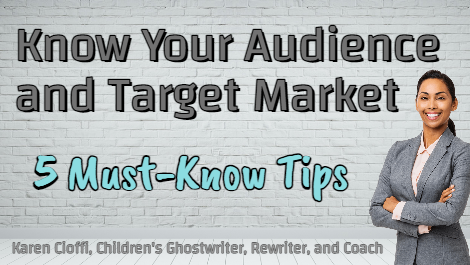I had a query from a potential client about a picture book series. He had already created the first book with the help of a graphic designer. According to the client, it was designed to be a coffee table book. People would buy it because it looks good, and they’d want to have it visible. The book was to be a basic learning tool for young children, with only one or two sentences per page. As he explained the project to me, I told him it sounded like the book should be geared toward four to six-year-olds. Yet he kept mentioning that it’s a coffee table book that adults would like to show off. This author was having difficulty figuring out exactly where his book would fit. If he didn’t know where it’d fit and I couldn’t figure out what he was talking about, how on earth would an audience figure it out. Who would buy a book with NO specific target audience? Okay, now this isn’t to say it couldn’t find an audience as I haven’t seen the actual book, but who would he market to? A child? An adult? Both? My other question would be, if he wants to attract adults with a cool-looking graphic book, why make it a children’s book? Why not make it specific to adults? It’s one of the most perplexing queries I’ve ever received. BOOK MARKETING 101: is to know your audience. You need to know your target market. In regard to marketing goals, if you don’t know where you want to go, it’s pretty hard to get there. That’s why it’s essential to know your audience and target market if you intend to sell books. IDENTIFY YOUR BOOK’S AUDIENCE AND TARGET MARKETING Let’s first go over who your audience is and who your target market is. -Your audience is the children who will read your book. -Your target market are the people who will actually buy the book. To determine who’ll be reading your book and who’ll be buying it, it’s a good idea to answer some questions. 1. Who is your audience? In the case of children’s books, children are the audience. 2. Who is your target market? Will it be parents, teachers, the children themselves for the chapter book and middle grade ages? You will need to know specifics about your book for this question. Consider the audience age group. This will help identify the genre. -Picture books are generally for four-eight-year-olds. -Chapter books are in the 7-10 age group range. -Middle-grade books in the ten-twelve age group range. -Young-adult books are thirteen and up. Then there’s the genre within the genre. Maybe you’ve written a fantasy or a sci-fi. Maybe you’ve written a mystery, a humorous book, or an action-packed adventure. Maybe you’ve written a historical fiction or a nonfiction book. It’s also possible that you’ve written a textbook or educational resource for a specific grade. You should also consider the theme. I have a series of children’s picture books, The Adventures of Planetman, that focuses on the environment using fantasy and superheroes. When promoting the Planetman books, I have “Teaching children about the environment” in the blurbs and memes. All this must be considered. And your marketing efforts should be directed toward those who will be interested. 3. Is the protagonist a boy or girl? While some books can cross genders, your audience will usually be boys or girls. Not both. You might also have anthropomorphic characters. 4. Who will actually buy the book? With children’s books, it’s parents who usually buy the books for their children. It’s also possible your target market will be libraries and schools. You might also be aiming for bulk purchases from wholesalers. Maybe you’ll be targeting all of the above. But, even if you sell in bulk to wholesalers, the parents will be the end purchaser. 5. Where does your audience and target market spend time? When writing children’s books, your audience will sometimes also be your target market. Children in the chapter book and middle grade ages will decide what books they want to read. It’s important to keep this in mind. A. Social media platforms: Facebook, Twitter, TikTok, YouTube, and Instagram Look for groups related to your book’s genre or theme. Follow hashtags relevant to your book. Use book related hashtags to connect with bookstagrammers. And engage with BookTok communities. B. Online forums and Communities Sites like Reddit, Goodreads, and even Quora are helpful. Join discussion groups, answer questions related to your book’s topic. Become involved. C. Book Clubs Find local and online book clubs that focus on your genre. Connect with book club leaders and organizers. Start by searching online for book clubs, attend local events, and reach out to book clubs through various channels. Consider offering signed copies, promotional items, and even virtual visits to book clubs. D. Blogs, Websites, and Podcasts Search for blogs, websites, and podcasts that are in line with your genre. Reach out and request to guest blog or do a podcast. Most bloggers and podcasters will be happy to have fresh content. Answering these five questions will help you get a handle on your audience and market.

Writing Tips from the Book, Story Genius
Visuals in Your Book Marketing
Book Synopsis, Book Description, Book Review – What’s the Difference?

I’m a working children’s ghostwriter, rewriter, and coach. I can help turn your story into a book you’ll be proud to be the author of, one that’s publishable and marketable.
OTHER HELP I OFFER:
HOW TO WRITE A CHILDREN'S FICTION BOOK
A DIY book to help you write your own children’s book.
FICTION WRITING FOR CHILDREN eCOURSE
4-Weeks / 8 Sections Guided Self-Study Mentoring Program
You can contact me at kcioffiventrice@gmail.com.


1 thought on “5 Tips to Determine Your Audience and Target Market”